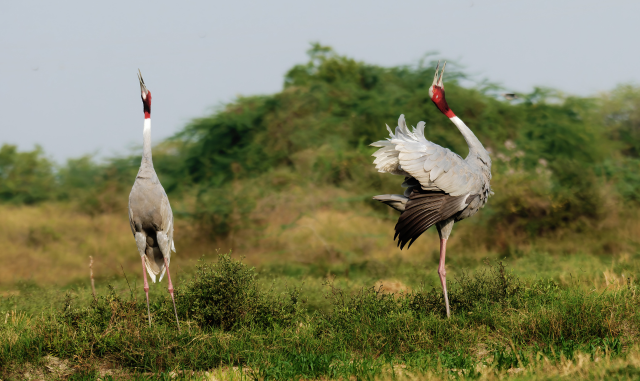Love Melodies: The Enduring Romance of Sarus Cranes
The Sarus crane (Antigone antigone) holds the distinction of being the world’s tallest extant flying bird, reaching a towering height of up to 1.8 m (5 ft 11 in). This majestic crane, standing as tall as an average person when on land, is revered in Indian culture as a symbol of marital fidelity, embodying the belief in lifelong monogamous bonds and the profound grief experienced at the loss of a mate, sometimes leading to self-imposed starvation. The species finds its stronghold in India, where it enjoys traditional reverence and coexists with humans in agricultural landscapes. Unfortunately, in other regions, the Sarus crane has faced extirpation from many of its former habitats.
 Distinguished by its large size, the adult Sarus crane boasts grey wings and body, a bare red head and upper neck, a greyish crown, and a lengthy greenish-grey bill. In flight, its straight neck and black wing tips are prominent features, while its long, pink legs trail gracefully behind. The crane’s characteristics include a grey ear covert patch, orange-red irises, and a greenish-grey bill, with juveniles displaying a yellowish base to the bill and fully feathered brown-grey heads. The bare red skin on the adult’s head and neck intensifies in color during the breeding season, featuring a rough texture covered by papillae, along with a narrow region around and behind the head adorned with black, bristly feathers. Plumage does not vary between sexes, although males tend to be larger on average.
Distinguished by its large size, the adult Sarus crane boasts grey wings and body, a bare red head and upper neck, a greyish crown, and a lengthy greenish-grey bill. In flight, its straight neck and black wing tips are prominent features, while its long, pink legs trail gracefully behind. The crane’s characteristics include a grey ear covert patch, orange-red irises, and a greenish-grey bill, with juveniles displaying a yellowish base to the bill and fully feathered brown-grey heads. The bare red skin on the adult’s head and neck intensifies in color during the breeding season, featuring a rough texture covered by papillae, along with a narrow region around and behind the head adorned with black, bristly feathers. Plumage does not vary between sexes, although males tend to be larger on average.
Sarus cranes inhabit Southeast Asia, northern India, and northern Australia, with three distinct populations identified. The Indian Sarus crane resides in northern and central India, Pakistan, and Nepal, while the Eastern Sarus crane is now limited to Vietnam and Cambodia, with a smaller population in Myanmar.
The Australian Sarus crane populates northern Australia. Predominantly nonmigratory, some populations may engage in short-distance migration. These birds primarily inhabit wetlands, including canals, marshes, and ponds, often in proximity to human settlements. They also occupy cultivated areas and high-altitude wetlands, with breeding occurring inland in wet areas. During the dry season, Sarus cranes can be found in shallow wetlands, wet grasslands, or rice fields.
Beyond their physical attributes, Sarus cranes exhibit sentient qualities, forming lifelong bonds, experiencing emotions akin to humans, and expressing love with remarkable tenderness. In India, a promising symbiotic relationship between local farmers and these cranes is emerging, ensuring the species’ survival and fostering hope for harmonious coexistence.
Known for their resonant trumpeting calls, produced by the elongated trachea coiled within the sternal region, Sarus cranes engage in captivating displays of unity and posturing. These displays, including synchronized calling and intricate “dancing” movements, occur during both breeding and non-breeding seasons. The “dance” involves a short series of jumping and bowing movements as one crane circles around its partner, adding a touch of grace to the natural world.
This was photographed at Nalsarover, Gujarat, India.

These rare photographs have been clicked and contributed by K. Shiva Kumar, a professional Wildlife Storyteller (M.A in Journalism & Mass Communication, an alumnus of Central University Of Odisha, Koraput) from Hyderabad, Telangana.
K. Shiva, is passionate about wildlife conservation. Through his work, he hopes to inspire greater appreciation for the wildlife that shares our planet and encourages conservation action.


Comments are closed.